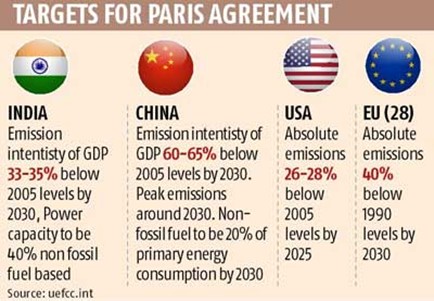PREVIOUS
India’s emission in 2023
December 5 , 2023
462 days
445
0
- A government report ‘The Third National Communication to the United Nations Framework Convention on Climate Change’ was released.
- It outlines the nation’s substantial progress in decoupling economic growth from greenhouse gas emissions.
- India achieved an impressive 33% reduction in GDP emission intensity from 2005 to 2019, surpassing targets 11 years early.
- Despite 7% annual GDP growth, emissions rose only 4% per year.
- India, with 17% of the world’s population, contributes less than 4% of global carbon emissions.
- India created an additional carbon sink of 1.97 billion tonnes of CO2 equivalent during the same period.
- The country is on track to achieve its target of reducing GDP emission intensity by 45% by 2030, compared to 2005 levels.
- The energy sector contributed the most to anthropogenic emissions (75.81%), followed by agriculture (13.44%), Industrial Process and Product Use (8.41%), and waste (2.34%).
- The Land Use, Land-Use Change, and Forestry (LULUCF) sector removed a significant 4,85,472 gigatonnes of carbon dioxide equivalent (GgCO2e) of emissions.
- India proposes to host the annual UN climate talks in 2028.
- India stands out among developing countries, submitting its third national communication with GHG inventory of 2019.
- It is showcasing more recent data compared to other nations like China (2014), Brazil (2016), South Africa (2017), and Saudi Arabia (2012).
- India aims to achieve 50% cumulative electric power installed capacity from non-fossil fuel-based energy resources by 2030.
- The country is committed to becoming a net-zero economy by 2070, highlighting its dedication to long-term sustainability.

Leave a Reply
Your Comment is awaiting moderation.


